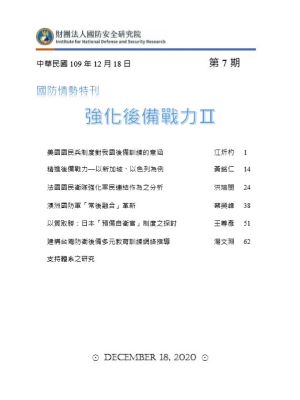肆、澳洲國防軍「常後融合」革新
2020.12.18
瀏覽數
448
Abstract
This article attempts to investigate Australia’s innovative approach of promoting “regular-reserve integration” through literature reviews on official documents. Despite the differences, Taiwan may find it valuable to understand how another Indo-Pacific country, with a similar population scale, conducted its reform of Reserve Forces.
The Australian Defence Force Reserves have gone through a series of reforms in the past fifty years. Under adjustment of strategic planning and purpose-driven policies after the Vietnam War, the role of ADF Reservists oscillated between “strategic logistics” and “operational readiness.” Such efforts can be categorized into three major stages: 1975-1990 “Total Force”, 1990-2000 “training standardization” and post-2000 “regular-reserve integration.”
To tackle a significant decline in its reserve recruitment during the mid-2010s, the Australian Department of Defence introduced an innovative measure, the “Total Workforce System,” to uphold the ongoing regular-reserve integration, which increased the flexibility of definitions of both Regular and Reserve through modularizing duties and benefits. This new method aimed to create a military-civilian convertible talent pool, in order to cultivate a sustainable Defence Industry ecology and mitigate potential competition from the private sectors. In addition, it is worth looking at those institutional mechanism supporting both reservists and their employers, such as The Defence Reserve Service (Protection) Act 2001 and Defence Reserves Support Committee.
全文連結: 肆、澳洲國防軍「常後融合」革新.pdf

